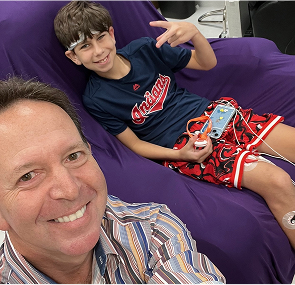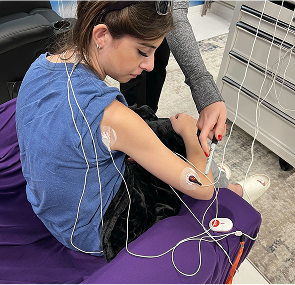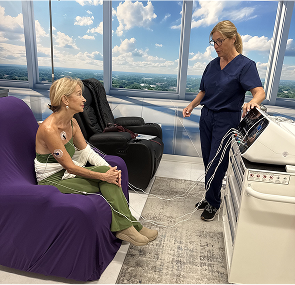Relief for People Living with Fibromyalgia through Scrambler Therapy
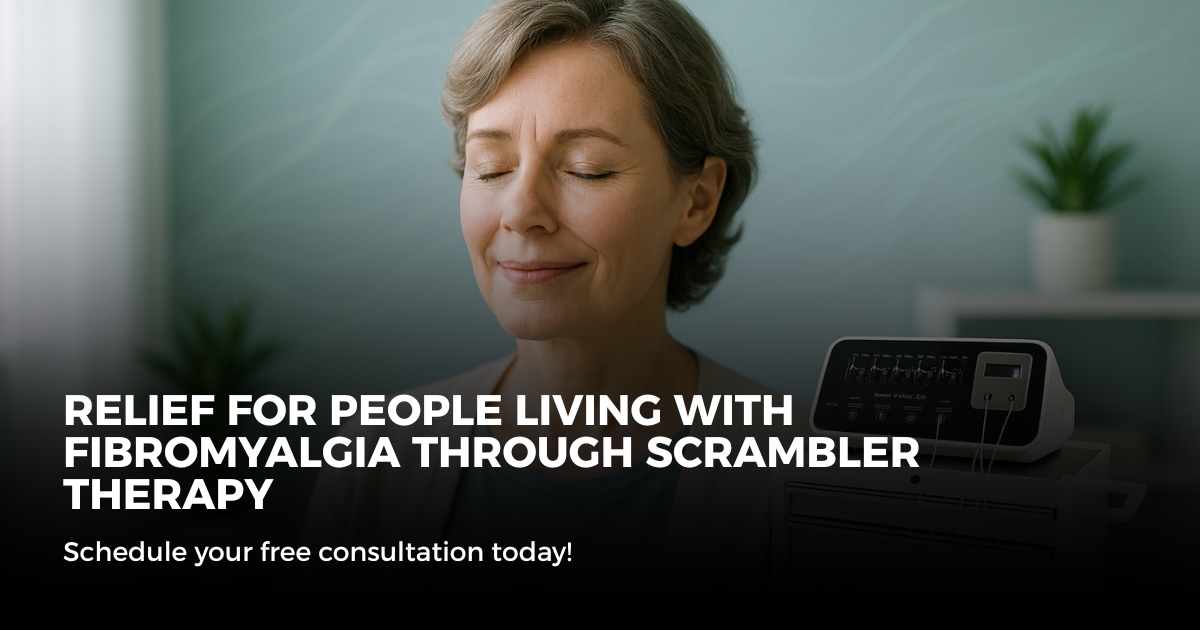
Scrambler Therapy is a non-invasive treatment that retrains the brain’s response to chronic pain. It uses electrical stimulation to override pain signals sent by damaged nerves, effectively “scrambling” them before they reach the brain.
This therapy targets neuropathic signals in the central nervous system, modifying how pain is interpreted by the brain. Instead of sending pain alerts, the Scrambler Therapy device delivers synthetic “non-pain” messages to the nerve endings.
Key neurological mechanisms include:
- Signal modulation: Replaces pain signals with synthetic, non-pain signals.
- Synaptic activity adjustment: Alters repeated pain patterns.
- Brain plasticity stimulation: Encourages the brain to form new, non-painful pathways.
Scrambler Therapy is non-invasive, meaning no surgery or medications are required. Unlike nerve blocks or opioids, it works through the natural retraining of nerve pathways and pain messaging systems.
Understanding Fibromyalgia and Chronic Pain Pathways
Fibromyalgia is a central pain disorder caused by faulty pain processing in the brain. It is not an inflammatory or autoimmune disease, but a neurological condition involving central sensitization.
This means the brain becomes hypersensitive to stimuli, leading to amplified pain perception, even when there's no physical cause.
Core symptoms include:
- Persistent fatigue
- Muscle tenderness
- Sleep disturbances
- Cognitive “fibro fog”
- Widespread pain lasting longer than 3 months
Key biological factors:
In fibromyalgia, the nociceptors (pain receptors) misfire repeatedly, sending excessive pain signals to the brain. Over time, these repeated patterns reshape the neural circuits, making the condition chronic.
How Scrambler Therapy Disrupts Fibromyalgia Pain Signals
Scrambler Therapy interrupts and replaces pain messages with artificial “no-pain” signals.
It works by placing surface electrodes on skin near the pain area. These electrodes deliver complex electrical signals designed to mimic normal nerve messages, which the brain interprets as non-painful.
Mechanism vs. TENS (Transcutaneous Electrical Nerve Stimulation):
Important mechanisms:
- Dorsal horn modulation: Targets spinal pain processing area.
- Electroceuticals: Uses digital signals as “medicine” for the brain.
- CNS retraining: Induces neuroplasticity to reduce chronic pain loops.
Patients often describe sensations like tingling, pulsing, or vibration, but no pain during treatment. The goal is pain signal interruption and eventual brain retraining.
Scientific Evidence Behind Scrambler Therapy for Fibromyalgia
Multiple clinical trials and reviews support Scrambler Therapy’s effectiveness in reducing fibromyalgia pain.
Key findings:
- A 2021 randomized control trial published in Pain Physician showed a 40% drop in pain scores (VAS) in fibromyalgia patients after 10 sessions.
- The NIH lists Scrambler Therapy under evidence-based non-pharmacological treatments for neuropathic pain.
- A 2019 meta-analysis found sustained pain relief for 3+ months in 65% of patients, compared to placebo.
Pain outcome metrics used:
- VAS score (Visual Analogue Scale)
- SF-36 (Quality of life score)
- Fatigue Severity Scale
- Pain Catastrophizing Scale
Scrambler Therapy consistently shows better durability of response than TENS or medications, especially for treatment-resistant fibromyalgia.
Benefits of Scrambler Therapy Over Conventional Treatments
Scrambler Therapy provides long-term pain relief without medication dependence or significant side effects.
Compared to other treatments:
Core benefits:
- Drug-free pain therapy
- No risk of dependency or sedation
- Safer for long-term use
- Neuroregenerative effects on nerve function
For those seeking natural pain relief for fibromyalgia, Scrambler Therapy offers a non-drug alternative with high safety and efficacy.
Who Is a Good Candidate for Scrambler Therapy for Fibromyalgia?
Ideal candidates are adults diagnosed with fibromyalgia who have persistent nerve-related pain unresponsive to other treatments.
Key candidacy indicators:
- Diagnosed chronic pain lasting longer than 6 months
- Failed prior therapies like medications, PT, or TENS
- No implanted devices (e.g., pacemakers)
- No open wounds near the treatment area
- Stable health condition without seizure disorders
Profile of typical responders:
What to Expect During a Scrambler Therapy Session
Each Scrambler Therapy session lasts 30–50 minutes in an outpatient clinic.
Step-by-step session breakdown:
- Electrode placement: Technician places electrodes near—but not directly on—the pain site.
- Stimulation: Device delivers low-frequency electrical pulses.
- Sensation: Mild tingling or pressure, but not painful.
- Adjustment: Intensity is tailored in real-time for comfort.
- Session frequency: Typically, 10–12 sessions, often daily over two weeks.
Therapy technicians monitor your response and adjust protocols accordingly. Patients often notice a cumulative effect, with pain decreasing over the course of treatment.
Patient Success Stories Using Scrambler Therapy for Fibromyalgia
Many fibromyalgia patients report dramatic improvements in daily life after Scrambler Therapy.
Case study 1:
Maria, 42, had suffered for 8 years with widespread pain. After 10 sessions, her VAS score dropped from 8 to 3, and she reported improved sleep and fewer flare-ups.
Case study 2:
Tom, 56, failed multiple antidepressants and opioids. Post-therapy, he regained mobility, reduced fatigue, and returned to work part-time.
Common success markers:
- Reduced pain intensity
- Longer pain-free days
- Better functional mobility
- Improved sleep and mood
- Enhanced quality of life
These patient testimonials show Scrambler Therapy as a viable long-term strategy for managing fibromyalgia nerve pain.
Potential Side Effects and Risks of Scrambler Therapy
Scrambler Therapy is FDA-cleared and has a high safety profile.
Known side effects:
- Mild skin irritation (redness where electrodes were placed)
- Tingling or warmth during stimulation
- Temporary fatigue after sessions
No known serious adverse effects have been reported in published clinical studies. It is considered a non-invasive fibromyalgia treatment with minimal risk.
Caution required for:
- Patients with implanted electronic devices
- Pregnant women
- Open skin lesions near electrode area
Always discuss medical history with a qualified provider to assess risk profile.
Scrambler Therapy Availability and Cost for Fibromyalgia Patients
Scrambler Therapy is available at specialized pain clinics across the U.S.
Insurance status:
- Some insurers partially cover treatment under neuropathic pain therapy codes.
- Medicare coverage varies by region and medical necessity.
- Out-of-pocket cost ranges from $300–$500 per session.
Access options:
Integrating Scrambler Therapy Into a Holistic Fibromyalgia Treatment Plan
Scrambler Therapy works best as part of a multimodal fibromyalgia treatment plan.
Complementary strategies include:
- Anti-inflammatory diet (omega-3s, whole foods)
- Gentle exercise (tai chi, swimming, walking)
- CBT (Cognitive Behavioral Therapy) for mood and pain management
- Activity pacing to avoid flare-ups
- Sleep hygiene techniques
Mind-body approaches like meditation and breathing exercises can enhance the neuroplastic benefits of Scrambler Therapy.
Combining therapies creates a synergistic effect and supports long-term management.
FAQs About Scrambler Therapy for Fibromyalgia
Does Scrambler Therapy permanently relieve fibromyalgia pain?
No. While many patients experience long-term relief, periodic booster sessions may be needed.
How many sessions are required to feel a difference?
Most patients report improvement after 4–6 sessions. Full benefit typically occurs after 10–12 sessions.
Is Scrambler Therapy FDA-approved?
Yes. The device is FDA-cleared for chronic pain, including neuropathic conditions.
Can Scrambler Therapy be combined with medication?
Yes. It can be safely used alongside antidepressants, muscle relaxants, or supplements.
What are the chances it won’t work?
About 20–30% of patients may not respond, especially if nerve damage is severe or diagnosis is unclear.
Experiencing Chronic Pain in South Florida?

Discover South Florida Scrambler Therapy is one of the nation’s leading clinics for noninvasive chronic pain relief, offering FDA-cleared Scrambler Therapy® for adults and children. Co-founded by Dr. Rick Markson, one of the few practitioners worldwide to receive advanced certification directly from the therapy’s inventor in Rome, our clinic delivers globally recognized expertise with compassionate, personalized care. If you or a loved one is living with treatment-resistant nerve pain, we invite you to schedule a consultation and explore a life beyond pain.
Recommended Reads:
📘 What is scrambler therapy?
📘 What to Expect During a Scrambler Session
📘 CRPS Pain Relief Without Drugs—Real Patient Stories
📘 Conditions that scrambler therapy can treat
Take the Next Step: Free Consultation at South Florida Scrambler
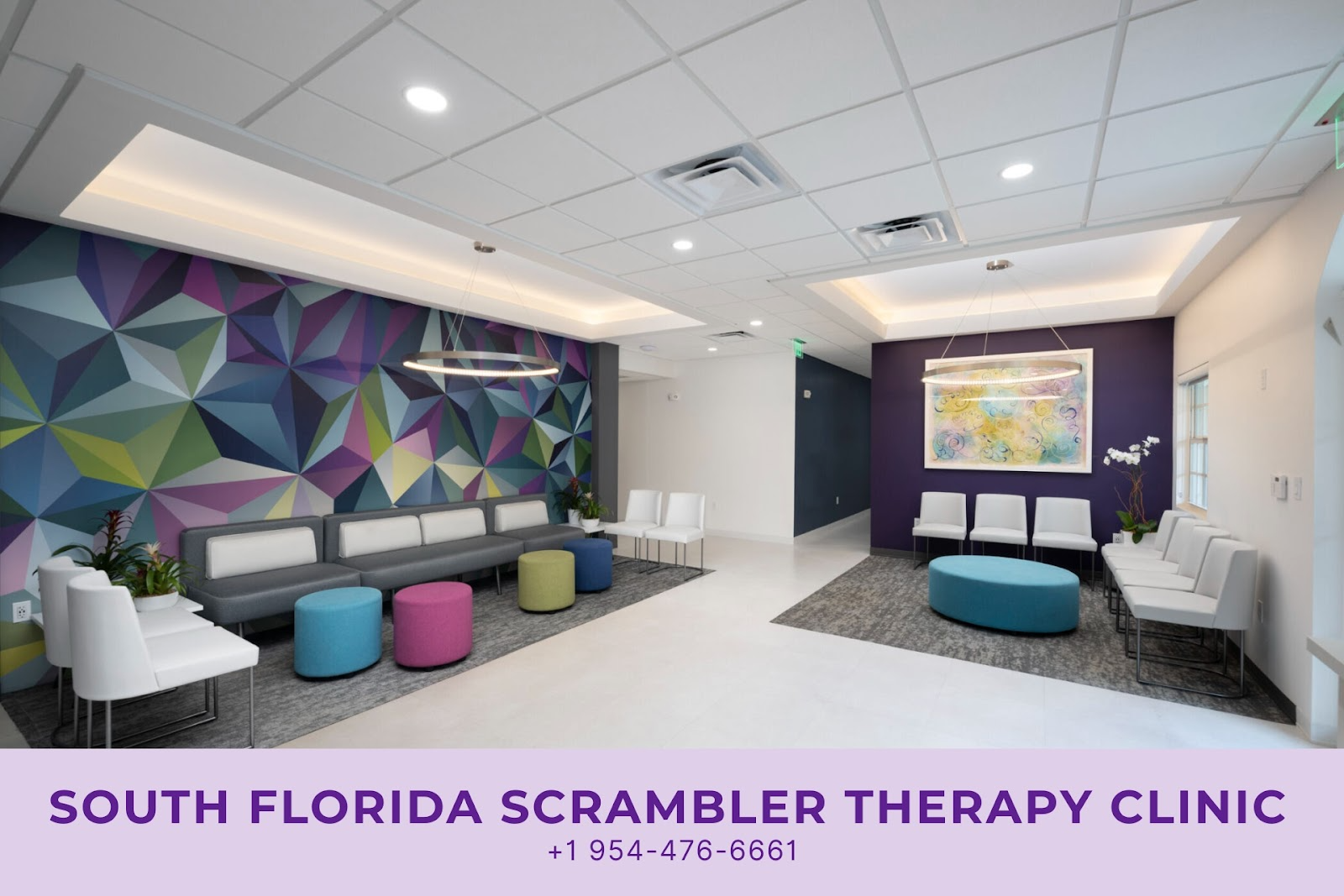
Every day counts when we suffer from chronic pain. South Florida Scrambler Therapy offers a free initial consultation to determine if Scrambler is right for you. Schedule Today:
- Speak directly with Dr. Rick Markson’s team
- Learn about treatment protocols and insurance
- Complete a customized treatment plan
- Start seeing results within days, not months
📞 Call Now or Visit website: www.southfloridascramblertherapy.com
📍 We serve Palm Beach, Fort Lauderdale, and Miami from our location at 100 NW 100th Ave, Plantation
You Can Follow Us through Our Social Media:
📸Instagram—Day-in-the-life stories from our patients
👍Facebook—Success journeys and community support
You deserve to laugh, and enjoy life without pain. The journey starts here.
Start Your Pain-Free Journey Today
